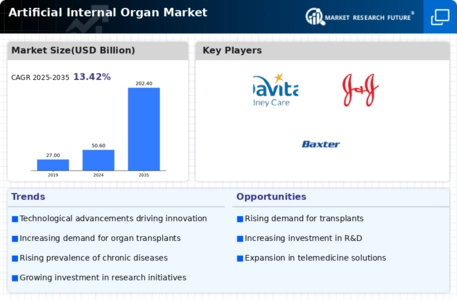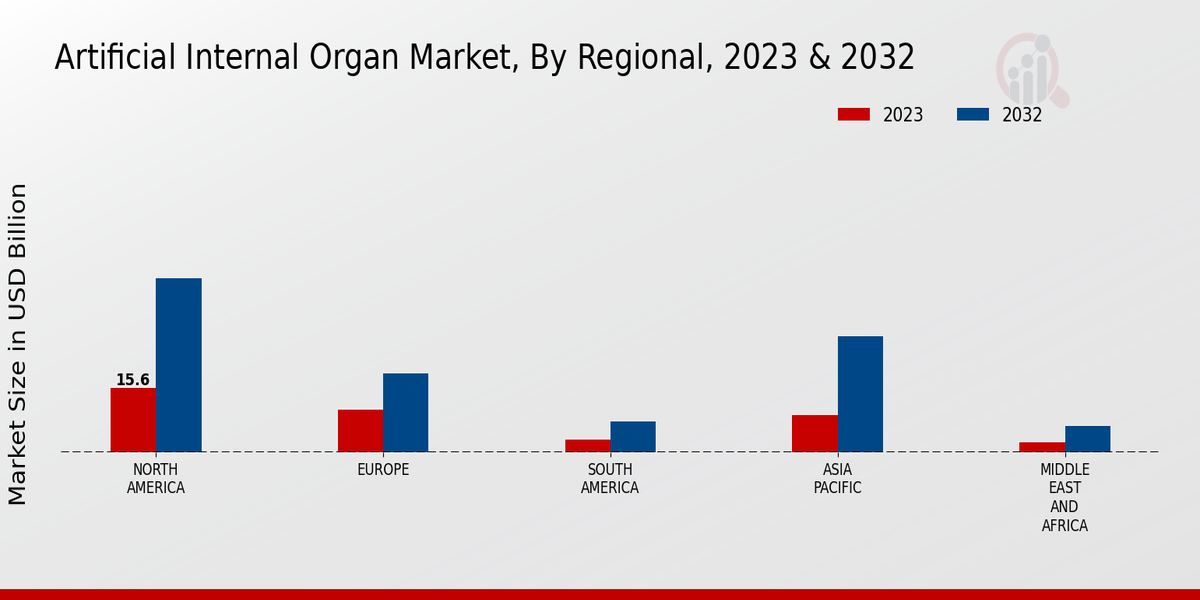Market Growth Projections
The Global Artificial Internal Organ Market Industry is on an upward trajectory, with projections indicating a market value of 50.6 USD Billion in 2024 and a remarkable increase to 202.4 USD Billion by 2035. This growth reflects a compound annual growth rate of 13.42% from 2025 to 2035, driven by various factors including technological advancements, rising chronic disease prevalence, and increased healthcare investments. The market's expansion signifies a robust demand for innovative solutions in organ replacement and support, highlighting the critical role of artificial organs in modern healthcare.
Rising Prevalence of Chronic Diseases
The Global Artificial Internal Organ Market Industry is experiencing growth due to the increasing prevalence of chronic diseases such as diabetes, heart disease, and renal failure. These conditions often necessitate the use of artificial organs to sustain life and improve quality of life. For instance, the demand for artificial kidneys and heart valves is surging as more individuals require these life-saving devices. The market is projected to reach 50.6 USD Billion in 2024, reflecting a significant response to the healthcare needs of an aging population and the growing incidence of lifestyle-related diseases.
Regulatory Support and Approval Processes
Regulatory support plays a pivotal role in the Global Artificial Internal Organ Market Industry. Governments are increasingly streamlining approval processes for medical devices, facilitating quicker access to innovative artificial organs. This regulatory environment encourages manufacturers to invest in research and development, leading to a broader range of products entering the market. For example, expedited pathways for the approval of life-saving devices enhance the availability of artificial organs for patients in need. As a result, the market is expected to flourish, with a projected growth trajectory that aligns with the anticipated rise to 202.4 USD Billion by 2035.
Technological Advancements in Medical Devices
Technological innovations are propelling the Global Artificial Internal Organ Market Industry forward. Advances in materials science, biocompatibility, and miniaturization of devices enhance the functionality and acceptance of artificial organs. For example, the development of 3D printing technology allows for the creation of customized implants that better fit individual patients. Such innovations not only improve patient outcomes but also expand the market's potential. As these technologies evolve, the market is expected to grow significantly, with projections indicating a rise to 202.4 USD Billion by 2035, driven by continuous improvements in device performance and patient care.
Increased Investment in Healthcare Infrastructure
Investment in healthcare infrastructure is a critical driver for the Global Artificial Internal Organ Market Industry. Governments and private sectors are allocating substantial resources to enhance healthcare facilities and services, particularly in developing regions. This investment leads to improved access to advanced medical technologies, including artificial organs. For instance, initiatives aimed at upgrading hospitals and clinics in emerging economies facilitate the adoption of these technologies. As a result, the market is likely to witness a compound annual growth rate of 13.42% from 2025 to 2035, reflecting the growing commitment to healthcare advancements.
Growing Awareness and Acceptance of Artificial Organs
The Global Artificial Internal Organ Market Industry benefits from increasing awareness and acceptance of artificial organs among patients and healthcare providers. Educational campaigns and success stories of patients living with artificial organs contribute to a more positive perception of these technologies. This shift in mindset encourages more individuals to consider artificial organs as viable treatment options. As awareness grows, the demand for these devices is expected to rise, further propelling market growth. The industry is poised for expansion, with projections indicating a market value of 50.6 USD Billion in 2024, as more patients seek innovative solutions for their health challenges.





